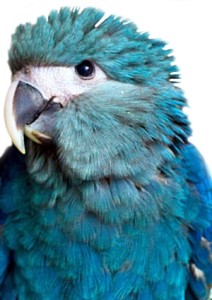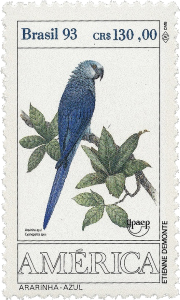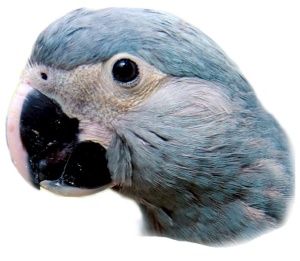
 Little blue macaw, Spix macaw, Cyanopsitta spixi.
Little blue macaw, Spix macaw, Cyanopsitta spixi.
With the release of the 2011 3-D animated feature Rio, attention was focused on a species of bird that is on the critically endangered list and has, unofficially, been declared extinct in the wild – the spix macaw. This bird was first discovered in 1638. George Marcgrave, a German naturalist who was working in Pernambuco in Brazil at the time, was the first person to describe it. The bird, however, is named after another German naturalist, Johann Baptist von Spix. Von Spix captured a spix’s macaw bird on the banks of the Rio Sao Francisco in Brazil in 1819.
Scientific Name
The spix’s macaw is also known as the little blue macaw. The scientific name for little blue macaw is Cyanospitta spixi. It is a mixture of two ancient languages – Cyano comes from kuano or blue and psittakos means parrot in ancient Greek and spixii is the Latin form of von Spix. Put together Cyanospitta spixii translates into blue parrot of Spix.
When Johann Baptist von Spix captured the bird, he erroneously called it the Arara hyacinthinus. In 1832, Johann Wagler, a German professor of zoology realized that the name was incorrect since it coincided with the Psittacus hyacinthinus, or the hyacinth macaw. He saw that the bird was a different color and size than the hyacinth macaw and called it Sittace spixii. The correct genus for this species was finally assigned by Prince Charles Bonaparte, who was a naturalist, in 1854. He named it Cyanospitta spixii, as he realized that there were many differences between this macaw bird and other blue macaws.
Distribution
While the spix’s macaw has been known for a 150 years, people have been trading during this time, it was not until 1985-86 that it was traced back to a region near the Rio Sao Francisco in northern Bahia, Brazil. At this time, only three birds remained. Since no conservation efforts were effective in ending the bird trade at the time, these three birds were captured for trade. In July 1990, it was discovered that there was a single male in this area, who had paired with a female Propyrrhura maracana or blue-winged macaw.
Tony Juniper was one of the group of the 1990 expedition to Brazil, they located the last know Little Blue macaw living in the wild. Tony Juniper wrote a book Spix’s Macaw: The Race to Save the World’s Rarest Bird, in this book he tells a beautiful story of the species’ history, how it came to demise in the late 20th century, all efforts that went into trying preserve the Spix Macaws through captive breeding.
In order to start a new population, a female little blue macaw was released from captivity in this region in 1995. Unfortunately for the conservation efforts, the female spix macaw disappeared approximately seven weeks after release and is suspected to have run afoul of a power line. The pair discovered in 1990 was still around in 2000 but disappeared that year.
In 2000, it was estimated that there was a population of about 50-60 spix’s macaws in captivity. Most of these were bred in captivity. In 2012, the number went up to 80. In addition, there are estimated to be about 13 birds in private hands.
There have been some reports of the spix macaw parrot being sighted in the Serra da Capivara National Park, news that is encouraging for conservationists. Sadly, none of these sightings have been confirmed officially.
Status
 In 1988, when the three birds were captured, the species was put on the IUCN Red List and listed as threatened. From 1994 till now the species has been listed as Critically Endangered – not surprising, since at last count there were approximately a hundred of these birds known and they were all in captivity, either in conservationist or private hands.
In 1988, when the three birds were captured, the species was put on the IUCN Red List and listed as threatened. From 1994 till now the species has been listed as Critically Endangered – not surprising, since at last count there were approximately a hundred of these birds known and they were all in captivity, either in conservationist or private hands.
The reason the spix macaw isn’t officially considered extinct is that not all tracts of its habitat have been searched thoroughly. Nevertheless, the last known spix’s macaw in the wild disappeared in 2000. Even if a population is found, it is very unlikely to be of a big size and therefore, the bird remains on the list of critically endangered species.
Description
 Although for a long time, the spix macaw was confused with other blue macaws, it is in fact quite different. For one thing, it is smaller than its blue macaw counterparts. For another, its facial attributes are quite different.
Although for a long time, the spix macaw was confused with other blue macaws, it is in fact quite different. For one thing, it is smaller than its blue macaw counterparts. For another, its facial attributes are quite different.
The spix’s macaw is about 56 cm or 22 in. in length, with a tail length of 26-38 cm or 10-15 in. The wing length of the bird is about 30 cm. or 9.7 to 11.18 in. While the male and female are the same in color, they do differ in weight, with the average male being about 318 grams or 11.2 oz. and the average female is about 288 grams or 10.2 oz.
The head of the spix macaw has blue-grey plumage. The underparts are pale blue in color. The most bright and shiny blue is on the wings, tail and the upper parts. The bird has bare facial skin, which in adults is grey but in juveniles is pale grey. Adult birds have beaks that are dark brown in color, while in juveniles there is a white stripe along the center of the beak. Lastly, the adults have yellow irises whereas the juveniles have brown irises.
Sexing – Sexual Differences
All the macaws are sexually monomorphic. This means the sex of the macaws cannot be clearly determined by their physical characteristics. But as per their appearance when fully grown the male macaws are slightly larger than their female counterparts with larger heads. But this is not an exact way. There are better ways to determine this.
To determine the sex of the macaw there are a few ways to go about it. By far the best way to do it by DNA test. This doesn’t involve any potential harm to the bird. It is also a very precise way. This way is also suitable for examination of nestlings, at an age that sex organs are not yet developed. It can also be used for determination of sex on shell membrane right after the hatching of a chick.
Diet – what’s on the menu?
The spix’s macaw is considered a frugivore and granivore. Among its staple diet are the fruits of the fachiero cacti or Cereus squamosus, pau-de-colher cacti or Maytenus rigida and zizyphus joazeiro cacti and the seeds of favela or faveleira trees and pinhao-brabo trees. It also eats the fruit of the licuri palm. Yes a lot of fancy food names, they also don’t mind a bite of clay every now and then, macaw species can be observed flocking and feasting on clay, here’s a great video:
The captive little blue macaw will like to eat a variety of fruits, seeds and nuts along with vitamins and mineral supplements. The supplements are necessary as there are dietary requirements that would be naturally available to the bird in the wild but isn’t in as easily in captivity.
A good way to increase little blue macaws trust and to make the parrot feel more affectionate towards you is to feed it by hand. It can be fed foods such as eggs, small amounts of beef which have been cooked well and porridge. It’s always well to remember, however, that the bird is meant to eat fruits and seeds and as much as possible to stick to its natural diet.
Behavior
The Spix macaw is known to prefer to travel in pairs or family groups rather than in flocks. In the wild, they generally travel along the seasonal rivers while looking for sustenance and nesting, an activity they tend to stick to the treetops for. They also prefer routines. It has been observed that they do the same activity at the same time every day, follow the same flight paths and scavenge the same areas. They follow these routines in their social interactions as well.
Not much is known about how much territory one spix macaw will need as there are no birds in the wild to be studied. Their behavior can only be speculated upon and based upon the behavior of the last male, who as we know went of the radar in the year 2000.
Read more about behavior in macaws here.
What’s killing them?
The two biggest reasons behind the decline of this species are trapping and the destruction of its habitat. Considering the beauty and the rarity of the Cyanopsitta spixi, they have been captured and sold almost since they were discovered. Trappers made no distinction in capturing the birds, taking adults, juveniles and even eggs from nests to sell to various collectors, whether local or foreign, international zoos included. Today Spix’s macaws can sell for up to $200000 in the underground market.
What are we doing about it?
Conservation efforts have been ongoing for a long time, although the biggest obstruction here is that quite a few of these birds are privately owned. Unfortunately, human greed and the desire to obtain and own the rare have placed the survival of the bird in jeopardy. Internal conflicts among conservationists have harmed these efforts as well, causing the Brazilian government to shut down the CPRAA (Permanent Committee for the Recovery of the Spix’s Macaw)in 2001, a move which dealt a huge blow to the efforts made towards conserving the little blue macaw. While some private owners have assisted in the efforts to preserve this bird, a lot more needs to be done. With just about a 100 birds around the world, all, it should be noted, in captivity, it has become crucial that people step up and take responsibility for preserving this beautiful species.
Fun fact
Presly is know to inspired the movie Rio.
Presley was one of the last of his species to be born in the wild. A lot of hopes were riding on him since the genetic pool of the macaw birds in captivity is very limited. All those birds are related to each other – a fact that causes inbreeding and genetic anomalies. Presley was outside that gene pool and would have brought diversity to it. Unfortunately, Presley passed away in 2014 without any progeny and the conservationists’ hopes were dashed.
Native environment – where did Spix’s Macaw live?
Spix macaws used to live in an area called Caatinga, Brazil. One of the main reasons they were choosing this location, was a specific tree that grows there – Tabebuia aurea. There are several names for this species of trees; Caribbean trumpet tree, silver trumpet tree or the tree of gold. We like the last one!
Besides the great names that people call these trees they are also the trees of chose for our little blue macaws to live in. They are not endangered globally, but locally in the Caatinga, Brazil it is not the same story. Unfortunate as it is, because of the unsustainable timber usage by the local population, these trees are in grave danger being cut down too fast. And as macaw parrot species are known to be a parrot of a habit, they like to nest at the same place year after year. This might present itself as a problem for the efforts of releasing spix macaws back into their natural habitat.
Most of the time the trees of gold are covered with beautiful flowers which are bright yellow in color. Along with providing shelter the tree of gold (yes we really like the name) also provide roosting and nesting for the little blue macaw, or should we say, used to. Alongside with being a great home for the spix macaws, the parrots also like to eat the seedpods of these trees. A house and a restaurant at the same time, smart little birds, these Spix’s.
It is understood that they were inhabited in the states of Bahia and Pernambuco spanning around 50 kilometers along the stretch of the Rio San Francisco.
These Caribbean Trumpet trees (or as we call it – the tree of gold) usually grow along the banks in periodic intervals and are usually surrounded by bushy and thorny vegetation. They are also unique and only found in Brazil.